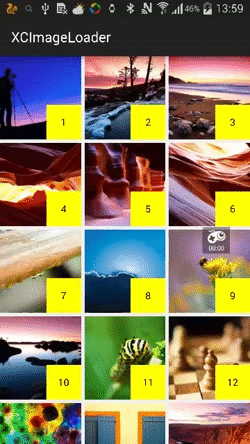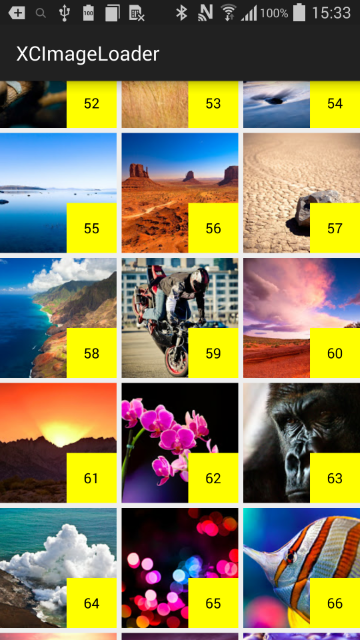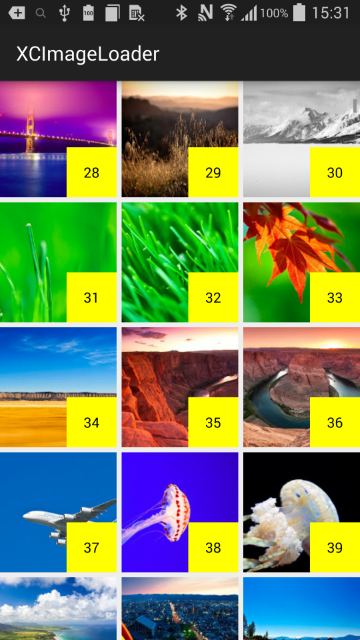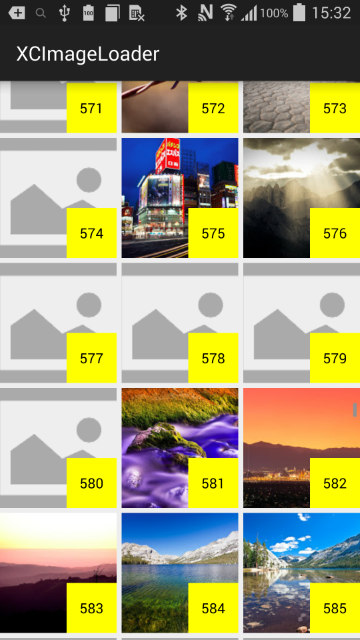一、概述
目前为止,第三方的图片加载框架挺多的,比如UIL , Volley Imageloader等等。但是最好能知道实现原理,所以下面就来看看设计并开发一个加载网络、本地的图片框架。
总所周知,图片框架中肯定需要用到缓存,这里我们和其他框架一样,采用LruCache来管理图片的缓存,当然图片的加载测量使用LIFO比较好点,因为要加载最新的给用户。
我们采用异步消息处理机制来实现图片异步加载任务:用于UI线程当Bitmap加载完成后更新ImageView。
加载网络图片的原理,就是如果启用了硬盘缓存,加载时,先从内存中加载,然后从硬盘加载,最后再从网络下载。下载完成后,写入硬盘和内存缓存。
如果没有启用硬盘缓存,就直接从网络压缩下载获取,最后加入内存缓存即可。
二、实例效果图
下面是个用GridView加载1000张图的实例效果图





三、框架解析
1、图片压缩
很多情况下,网络或者本地的图片都比较大,而我们的ImageView显示大小比较小,这时候就需要我们进行图片的压缩,以显示到ImageView上面去。
1.1、本地图片压缩
(1)获取ImageView所显示的大小
/** * 获取ImageView所要显示的宽和高 */ public static ImageSize getImageViewSize(ImageView imageView) { ImageSize imageSize = new ImageSize(); DisplayMetrics displayMetrics = imageView.getContext().getResources() .getDisplayMetrics(); ViewGroup.LayoutParams lp = imageView.getLayoutParams(); // 获取imageview的实际宽度 int width = imageView.getWidth(); if (width <= 0) {// 获取imageview在layout中声明的宽度 width = lp.width; } if (width <= 0) {// 检查最大值 width = getImageViewFieldValue(imageView, "mMaxWidth"); } if (width <= 0) { width = displayMetrics.widthPixels; } // 获取imageview的实际高度 int height = imageView.getHeight(); if (height <= 0) {// 获取imageview在layout中声明的宽度 height = lp.height; } if (height <= 0) {// 检查最大值 height = getImageViewFieldValue(imageView, "mMaxHeight"); } if (height <= 0) { height = displayMetrics.heightPixels; } imageSize.width = width; imageSize.height = height; return imageSize; }
上面代码中最大宽度,没有用getMaxWidth();用的是反射获取的,这是因为getMaxWidth竟然要API 16,没办法,为了兼容问题,只能采用反射机制,所以不太赞同反射。
(2)设置图片的inSampleSize
根据ImageView所要显示的大小和图片的实际大小来计算inSampleSize,实现如下:
/** * 根据ImageView的宽高和图片实际的宽高计算SampleSize */ public static int calculateInSampleSize(BitmapFactory.Options options, int reqWidth,int reqHeight) { int width = options.outWidth; int height = options.outHeight; int inSampleSize = 1; if (width > reqWidth || height > reqHeight) { int widthRadio = Math.round(width * 1.0f / reqWidth); int heightRadio = Math.round(height * 1.0f / reqHeight); inSampleSize = Math.max(widthRadio, heightRadio); } return inSampleSize; }
1.2、网络压缩
上面是本地的图片的压缩,如果是网络图片的话, 分两种情况,如果硬盘缓存开启的话, 就把图片下载到本地,然后在采用上面本地压缩方法;
如果硬盘缓存没有开启的话,才用BitmapFactory.decodeStream()来获取bitmap,然后和本地压缩一样的方法来计算采样率压缩。如下:
/** * 根据url下载图片并压缩 */ public static Bitmap downloadImageByUrl(String urlStr, ImageView imageview) { InputStream is = null; try { URL url = new URL(urlStr); HttpURLConnection conn = (HttpURLConnection) url.openConnection(); is = new BufferedInputStream(conn.getInputStream()); is.mark(is.available()); BitmapFactory.Options opts = new BitmapFactory.Options(); opts.inJustDecodeBounds = true; Bitmap bitmap = BitmapFactory.decodeStream(is, null, opts); //获取imageview想要显示的宽和高 ImageSize imageViewSize = ImageUtils.getImageViewSize(imageview); opts.inSampleSize = ImageUtils.calculateInSampleSize(opts, imageViewSize.width, imageViewSize.height); opts.inJustDecodeBounds = false; is.reset(); bitmap = BitmapFactory.decodeStream(is, null, opts); conn.disconnect(); return bitmap; } catch (Exception e) { e.printStackTrace(); } finally { try { if (is != null) is.close(); } catch (IOException e) { } } return null; }
图片压缩差不多就这样了,下面来看看图片加载框架的设计与实现
2、图片加载框架的设计架构
图片压缩完了,就放入我们的LruCache,然后通过setImageBitmap方法设置到我们的ImageView上。
图片加载框架的整体架构如下:
(1)、单例实现,单例默认不传参数,当然也支持传参单例调用框架。
(2)、图片缓存管理:包含一个LruCache用于管理我们的图片。
(3)、任务队列:每来一次新的加载图片的请求,封装成Task添加到的任务队列TaskQueue中去;
(4)、后台轮询线程:该线程在第一次初始化实例的时候启动,然后会一直在后台运行;当每来一次加载图片请求的时候,
除了会创建一个新的任务到任务队列中去,同时发一个消息到后台线程,后台线程去使用线程池去TaskQueue去取一个任务执行;
基本的框架设计架构就是上面这些,下面来看看具体的实现:
3、图片加载框架的具体实现
3.1、单例实现以及构造方法:
public static XCImageLoader getInstance() { if (mInstance == null) { synchronized (XCImageLoader.class) { if (mInstance == null) { mInstance = new XCImageLoader(DEAFULT_THREAD_COUNT,Type.LIFO); } } } return mInstance; } public static XCImageLoader getInstance(int threadCount,Type type) { if (mInstance == null) { synchronized (XCImageLoader.class) { if (mInstance == null) { mInstance = new XCImageLoader(threadCount,type); } } } return mInstance; } private XCImageLoader(int threadCount,Type type){ init(threadCount, type); } /** * 初始化信息 * @param threadCount * @param type */ private void init(int threadCount,Type type){ initBackThread(); //获取当前应用的最大可用内存 int maxMemory = (int) Runtime.getRuntime().maxMemory(); mLruCache = new LruCache<String,Bitmap>(maxMemory/8){ @Override protected int sizeOf(String key, Bitmap value) { return value.getRowBytes() * value.getHeight(); } }; //创建线程池 mThreadPool = Executors.newFixedThreadPool(threadCount); mTaskQueue = new LinkedList<Runnable>(); mType = type; mPoolTThreadSemaphore = new Semaphore(threadCount); }
3.2、后台轮询线程:
后台线程中,创建一个Handler用来处理图片加载任务发过来的图片显示消息。
/** * 初始化后台轮询线程 */ private void initBackThread() { //后台轮询线程 mPoolThread = new Thread(){ @Override public void run() { Looper.prepare(); mPoolThreadHandler = new Handler(){ @Override public void handleMessage(Message msg) { //从线程池中取出一个任务开始执行 mThreadPool.execute(getTaskFromQueue()); try { mPoolTThreadSemaphore.acquire(); } catch (InterruptedException e) { e.printStackTrace(); } } }; //释放信号量 mPoolThreadHandlerSemaphore.release(); Looper.loop(); } }; mPoolThread.start(); }
3.3、使用框架显示图片-加载图片并显示到ImageView上
加载显示图片的时候,判断是否有LruCache,如果有的话,就从LruCache中取出来加载显示;
否则的话,就新建一个图片加载任务并添加到任务队列中。
/** * 加载图片并显示到ImageView上 */ public void displayImage(final String path,final ImageView imageView ,final boolean isFromNet){ imageView.setTag(path); if(mUIHandler == null){ mUIHandler = new Handler(){ @Override public void handleMessage(Message msg) { // 获取得到图片,为imageview回调设置图片 ImageHolder holder = (ImageHolder) msg.obj; Bitmap bmp = holder.bitmap; ImageView imageview = holder.imageView; String path = holder.path; // 将path与getTag存储路径进行比较,防止错乱 if (imageview.getTag().toString().equals(path)) { if(bmp != null){ imageview.setImageBitmap(bmp); } } } }; } // 根据path在缓存中获取bitmap Bitmap bm = getBitmapFromLruCache(path); if (bm != null) { refreshBitmap(path, imageView, bm); }else{//如果没有LruCache,则创建任务并添加到任务队列中 addTaskToQueue(createTask(path, imageView, isFromNet)); } }
3.4、创建图片加载任务并添加到任务队列中
图片加载任务首先会判断是否从网络加载,如果是的话,再一次判断是否有LruCache和DiskCache,如果都没有的话, 就从网络下载加载;
如果不从网络加载,就直接从本地加载;最后无论是否网络加载,都要把图片写入到LruCache和DiskCache中去,并且刷新显示Bitmap到
ImageView上。
当然最后添加任务到任务队列后,会通过mPoolThreadHandler.sendEmptyMessage(24)方法来通知后台线程去任务线程池中取出一个
任务线程来执行。
/** * 添加任务到任务队列中 */ private synchronized void addTaskToQueue(Runnable runnable) { mTaskQueue.add(runnable); try { if (mPoolThreadHandler == null) mPoolThreadHandlerSemaphore.acquire(); } catch (InterruptedException e) { e.printStackTrace(); } mPoolThreadHandler.sendEmptyMessage(24); } /** * 根据参数,创建一个任务 */ private Runnable createTask(final String path, final ImageView imageView, final boolean isFromNet) { return new Runnable() { @Override public void run() { Bitmap bm = null; if (isFromNet) { File file = getDiskCacheDir(imageView.getContext(), Utils.makeMd5(path)); if (file.exists())// 如果在缓存文件中发现 { Log.v(TAG, "disk cache image :" + path); bm = loadImageFromLocal(file.getAbsolutePath(), imageView); } else { if (mIsDiskCacheEnable)// 检测是否开启硬盘缓存 { boolean downloadState = ImageDownloadUtils .downloadImageByUrl(path, file); if (downloadState)// 如果下载成功 { Log.v(TAG, "download image :" + path + " to disk cache: " + file.getAbsolutePath()); bm = loadImageFromLocal(file.getAbsolutePath(), imageView); } } else {// 直接从网络加载 bm = ImageDownloadUtils.downloadImageByUrl(path, imageView); } } } else { bm = loadImageFromLocal(path, imageView); } // 3、把图片加入到缓存 setBitmapToLruCache(path, bm); refreshBitmap(path, imageView, bm); mPoolTThreadSemaphore.release(); } }; }
3.4、显示Bitmap到ImageView上
通过UIHandler发消息来显示Bitmap到ImageView上去。
/** * 刷新图片到ImageView */ private void refreshBitmap(final String path, final ImageView imageView, Bitmap bm) { Message message = Message.obtain(); ImageHolder holder = new ImageHolder(); holder.bitmap = bm; holder.path = path; holder.imageView = imageView; message.obj = holder; mUIHandler.sendMessage(message); }
最后,框架中使用到了两个信号量,下面稍微解析下:
第一个:mPoolThreadHandlerSemaphore= new Semaphore(0); 用于控制我们的mPoolThreadHandler的初始化完成,我们在使用mPoolThreadHandler会进行判空,如果为null,会通过mPoolThreadHandlerSemaphore.acquire()进行阻塞;当mPoolThreadHandler初始化结束,我们会调用.release();解除阻塞。
第二个:mPoolTThreadSemaphore= new Semaphore(threadCount);这个信号量的数量和我们加载图片的线程个数一致;每取一个任务去执行,我们会让信号量减一;每完成一个任务,会让信号量+1,再去取任务;目的是什么呢?为什么当我们的任务到来时,如果此时在没有空闲线程,任务则一直添加到TaskQueue中,当线程完成任务,可以根据策略去TaskQueue中去取任务,只有这样,我们的LIFO才有意义。
四、框架的使用实例
这里,我们用一个简单GridView加载显示1000张图片来演示我们的框架使用。
4.1、布局文件实现:
activity_xcimager_loader.xml:
<RelativeLayout xmlns:android="http://schemas.android.com/apk/res/android"
xmlns:tools="http://schemas.android.com/tools"
android:layout_width="match_parent"
android:layout_height="match_parent"
tools:context=".XCImagerLoaderActivity">
<GridView
android:id="@+id/gridview"
android:layout_width="match_parent"
android:layout_height="match_parent"
android:numColumns="3"
android:horizontalSpacing="5dp"
android:verticalSpacing="5dp"
>
</GridView>
</RelativeLayout>
layout_gridview_item.xml:
<?xml version="1.0" encoding="utf-8"?> <RelativeLayout xmlns:android="http://schemas.android.com/apk/res/android" android:orientation="vertical" android:layout_width="match_parent" android:layout_height="120dp"> <ImageView android:id="@+id/image_view" android:layout_width="match_parent" android:layout_height="120dp" android:scaleType="centerCrop"/> <TextView android:id="@+id/text_pos" android:layout_width="50dp" android:layout_height="50dp" android:layout_alignParentBottom="true" android:layout_alignParentRight="true" android:text="1" android:gravity="center" android:textColor="#000000" android:background="#FFFF00" /> </RelativeLayout>
4.2、实例演示类文件实现:
public class XCImagerLoaderActivity extends AppCompatActivity { private GridView mGridView; private String[] mUrlStrs = ImageSources.imageUrls; private XCImageLoader mImageLoader; @Override protected void onCreate(Bundle savedInstanceState) { super.onCreate(savedInstanceState); setContentView(R.layout.activity_xcimager_loader); init(); mImageLoader = XCImageLoader.getInstance(3, XCImageLoader.Type.LIFO); } private void init() { mGridView = (GridView) findViewById(R.id.gridview); GridViewAdpter adapter = new GridViewAdpter(this,0,mUrlStrs); mGridView.setAdapter(adapter); } private class GridViewAdpter extends ArrayAdapter<String> { private Context mContext; public GridViewAdpter(Context context, int resource, String[] datas) { super(context, 0, datas); mContext = context; } @Override public View getView(int position, View convertView, ViewGroup parent) { if (convertView == null) { convertView = LayoutInflater.from(mContext).inflate( R.layout.layout_gridview_item, parent, false); } ImageView imageview = (ImageView) convertView .findViewById(R.id.image_view); imageview.setImageResource(R.mipmap.img_default); TextView textview = (TextView)convertView.findViewById(R.id.text_pos); textview.setText(""+(position + 1)); mImageLoader.displayImage(getItem(position), imageview, true); return convertView; } } }
框架的开发到此完成。
源码下载:http://download.csdn.net/detail/jczmdeveloper/9098759